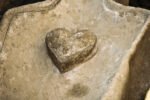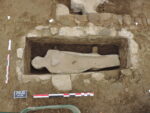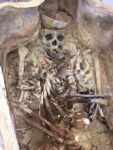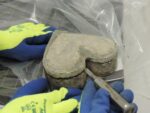 A heart-shaped lead urn found placed on the chest of a lead coffin buried in Flers, Normandy, has gotten an autopsy. The cardiotaph was discovered in 2014 during a preventive archaeology excavation in downtown Flers’ Place Saint-Germain, site of the former Saint-Germain parish church and cemetery. Two masonry vaults were unearthed, each containing an anthropomorphic lead coffin. The cardiotaph was on one of them. They date to the 17th-18th centuries.
A heart-shaped lead urn found placed on the chest of a lead coffin buried in Flers, Normandy, has gotten an autopsy. The cardiotaph was discovered in 2014 during a preventive archaeology excavation in downtown Flers’ Place Saint-Germain, site of the former Saint-Germain parish church and cemetery. Two masonry vaults were unearthed, each containing an anthropomorphic lead coffin. The cardiotaph was on one of them. They date to the 17th-18th centuries.
 It was a common practice in France from the Middle Ages to the 18th century for the elite to have the hearts of the deceased placed in heart-shaped containers and buried with their loved ones. This cardiotaph has no inscription, unlike the helpfully explanatory vital statistics found on the one holding the heart of the Knight of Brefeillac, and in 2015 both coffins were opened and excavated in the laboratory.
It was a common practice in France from the Middle Ages to the 18th century for the elite to have the hearts of the deceased placed in heart-shaped containers and buried with their loved ones. This cardiotaph has no inscription, unlike the helpfully explanatory vital statistics found on the one holding the heart of the Knight of Brefeillac, and in 2015 both coffins were opened and excavated in the laboratory.
 The skeletal remains found inside belong to adults. Their skulls had been sawn, indicating the bodies has been subjected to an embalming process typical of high-ranking personages, in this case likely the family of the Counts of Flers. Traces of organic remains — the scalp of one individual and textiles on the second — were also found. DNA samples were extracted from both individuals.
The skeletal remains found inside belong to adults. Their skulls had been sawn, indicating the bodies has been subjected to an embalming process typical of high-ranking personages, in this case likely the family of the Counts of Flers. Traces of organic remains — the scalp of one individual and textiles on the second — were also found. DNA samples were extracted from both individuals.
At the time, the cardiotaph was not part of the study. Researchers worked to develop an appropriate protocol to explore it and in September of this year, the cardiotaph was operated on. It was cut into with a small circular saw  then pried open. Inside it was filled with a brown grainy substance that smelled vaguely of peppermint. The filling was removed revealing a mummified human heart at the center. Dissection found the atrial and ventricular chambers of the heart and collapsed arteries.
then pried open. Inside it was filled with a brown grainy substance that smelled vaguely of peppermint. The filling was removed revealing a mummified human heart at the center. Dissection found the atrial and ventricular chambers of the heart and collapsed arteries.
The DNA sample taken from the heart will be compared to that of the individuals in the coffins. It could belong to one of them, or they could be a familiar relationship.
Documentary research, started in 2014, completes the excavation. In particular, it makes it possible to put forward hypotheses for the identification of the deceased to whom the heart present in the cardiotaph would belong and on which the DNA analysis will be based. A reasoned inventory of mentions of discoveries of cardiotaphs (rarely studied from the point of view of the funeral rite of embalming) is paired with an inventory of multiple funerals. The latter are identified by references to the division of the body and the burial of the heart in regional and extra-regional archives.
The deepening knowledge about the family of Pellevé and of La Motte Ango, barons and then counts of Flers since the 15th century, makes it possible to link the individual wishes of the various members of the dynasty with the status, but also the place that they occupy in the lineage and in the networks of regional and Parisian powers. Archival research on their funeral wishes (choice of burial, modest or non-modest funeral wishes, categorically declared desire or refusal to open the body for embalming, etc.), compared to what was actually implemented by the living, allow us to understand practices common to the nobility in the modern era. The results obtained for the case of Flers are also compared with other European examples.
Through different funerary choices, the documentary study aims to understand the perception that the members of this family had of themselves and of the rank they held in their social sphere. Funerals are indeed an eminently individual and private choice (as diverse as there are members in a family), but also a collective one, in line with the common practices of the noble elite in the modern era. Beyond the biographical studies that are necessary to place the archaeological remains in their historical context, the examination of wills and funeral costs is a rich resource for understanding the issues and the context of funeral practices, choice of burial, with the choice of the treatment of the body until the funeral home.